An engraving of a parade reveals much about electoral participation [10-minute interactive] […]
Wootton Bassett 1808

e

An engraving of a parade reveals much about electoral participation [10-minute interactive] […]

Learn how dress and decoration, made and worn by women, was part of campaigning [20-minute read] Paying heed to eighteenth-century women’s use of fashion for political ends, calls attention both to an understudied aspect of women’s political involvement as well as to the importance of material culture, visual impact, and the use of space in […]

In the long eighteenth century, a wide range of objects and accessories (from ceramics to metalwork) were available for appropriation and deployment at election time. Whether they were worn, seen, used, made, sold, purchased, presented, or exhibited, these items afforded voters and non-voters opportunities to express support for specific candidates and parties; encouraged broad engagement […]
Read More… from Displaying Partisan Identity: The Material Culture of Elections

Long eighteenth-century elections were noisy and frequently musical affairs. This exhibition recreates some of the music of elections, from the reign of Queen Anne to shortly before the Reform Act; from Liverpool to London; and from the worlds of street campaigning to the ‘polite’ ballroom. In these varied settings, songs and music fuelled the electoral […]
Read More… from The Soundscapes of Eighteenth-Century Elections

Find out how dancing was used to mobilize voters and their families. [5-minute read] In eighteenth-century elections, candidates were not just assessed on their speeches and campaign promises, they were also measured by the way they carried themselves, whether on the hustings or in the ballroom. While dancing may seem like an activity designed solely […]

One of the most curious and ludic phenomena of 18th-century popular politics [5-minute read] June 1768. Fifes, French horns, drums, and marrow bones can be heard in the streets of Wandsworth, now in south-west London but then still largely rural. A crowd has gathered, lining the high street in the tiny village of Garratt. Men […]


Following an election, collections of printed ephemera were sometimes published [20-minute read] These compendia might contain handbills, songs, visual prints, advertisements and addresses that had been published as part of the campaign. Such volumes have come to be known as ‘squib books’. A ‘squib’ is a short piece of satirical writing, generally taking the form […]

Standing as an MP was an expensive undertaking. Success often needed to be bought [15-minute read] The costs of campaigning remain expensive today, as they were in the eighteenth century. Over the course of centuries, however, the types of expenditures have shifted dramatically. In the eighteenth century, food and drink were key for ‘treating’ the […]

Candidates’ processions before and after elections were colourful and noisy events [15-minute read] From the issuing of the writ of election to the chairing of the successful candidates, parliamentary elections were replete with ritual, often long established by precedent within each community. Notably, these rituals included both voters and non-voters alike. Processions in particular were […]